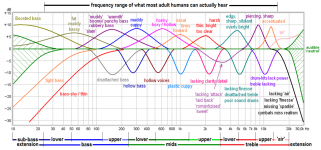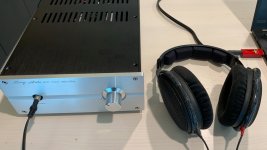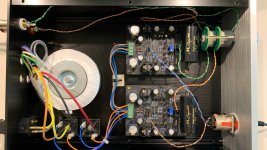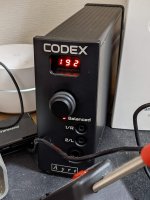As you can see from #1634, I normally first implement the notches as an inline add-on.
After listening for some time with, I then remove them and listen again.
If I then decide I want the notch after all, I can still decide whether to continue to use the add-on.
Or build it inside the phone internally (like in #1633).

Cheers,
Patrick
After listening for some time with, I then remove them and listen again.
If I then decide I want the notch after all, I can still decide whether to continue to use the add-on.
Or build it inside the phone internally (like in #1633).
Cheers,
Patrick
Correction. I wrote SRH940 earlier, I meant SRH840. Same basic idea.
Excellent write up on the SRH840, here.
I agree that fundamentally there's a bit too much treble and not quite enough bass, and that they are more at home in a studio than a den. Still think they have a lot of positives overall though.
Update: bought another set of HD-600. Don't mess with greatness as they say.
Excellent write up on the SRH840, here.
I agree that fundamentally there's a bit too much treble and not quite enough bass, and that they are more at home in a studio than a den. Still think they have a lot of positives overall though.
Update: bought another set of HD-600. Don't mess with greatness as they say.
>
Try his notch filter.
Or the SRH1540.
I am interested to try the SRH1540, definitely.
That is a great website. I mean seriously, how awesome is this:
Attachments
Yes, and I tried many of his mods.
And they really work as claimed.
Sometimes you just need to find tune a bit to personaly taste.
The Superlux 662 was also from his site, with a notch added.
The best 33€ I have ever spent on audio.
The other one was KZ ZS6 with the Loesch mod; great value for money.
KZ ZS6 IEM Modified
Patrick
And they really work as claimed.
Sometimes you just need to find tune a bit to personaly taste.
The Superlux 662 was also from his site, with a notch added.
The best 33€ I have ever spent on audio.
The other one was KZ ZS6 with the Loesch mod; great value for money.
KZ ZS6 IEM Modified
Patrick
To draw a line under the recent diversion:
I bought a new pair of Sennheiser HD600. They are post-2019 revamp, which drop the blue speckle finish for gunmetal grey and institute a couple of other tiny cosmetic changes but are otherwise identical.
I realized the balance problem with my old set was not a bad connection, but rather that the driver unit on the left side had popped out of the retaining clips. These headphones are surprisingly user-serviceable, so after learning on Youtube how to disassemble the earpiece it was fixed in no time.
This leaves me in the amusing position of owning two HD600s, manufactured over 20 years apart. No, the signature hasn't changed. The new ones sound slightly tighter / stiffer, the old ones a little ... tired.
The magic of the HD600s is present in both. That fast, exquisitely resolved upper bass register. The slight shading of the upper midrange and treble. It's because the don't, natively, have over-accentuated bass, that they pair so well with the Sapphire. The amp provides rock-like stability but it never overpowers.
The MDR1A are pleasant to listen to plugged into a smartphone/tablet etc., the bass boost compensates nicely for the weaker control and rolled off bass signal.
The Shure 840 don't satisfy under either situation. A pleasing bass balance is never found, though it gets close at very high volume levels. Again, that's in line with their design-for application as studio monitors.
Incidentally I'm trying a new USB DAC, the Korg DS-DAC-10. The headphone out is really bad, but the line output is interesting. The DAC is a bitstream but it transcodes up to 24/192 PCM.
I bought a new pair of Sennheiser HD600. They are post-2019 revamp, which drop the blue speckle finish for gunmetal grey and institute a couple of other tiny cosmetic changes but are otherwise identical.
I realized the balance problem with my old set was not a bad connection, but rather that the driver unit on the left side had popped out of the retaining clips. These headphones are surprisingly user-serviceable, so after learning on Youtube how to disassemble the earpiece it was fixed in no time.
This leaves me in the amusing position of owning two HD600s, manufactured over 20 years apart. No, the signature hasn't changed. The new ones sound slightly tighter / stiffer, the old ones a little ... tired.
The magic of the HD600s is present in both. That fast, exquisitely resolved upper bass register. The slight shading of the upper midrange and treble. It's because the don't, natively, have over-accentuated bass, that they pair so well with the Sapphire. The amp provides rock-like stability but it never overpowers.
The MDR1A are pleasant to listen to plugged into a smartphone/tablet etc., the bass boost compensates nicely for the weaker control and rolled off bass signal.
The Shure 840 don't satisfy under either situation. A pleasing bass balance is never found, though it gets close at very high volume levels. Again, that's in line with their design-for application as studio monitors.
Incidentally I'm trying a new USB DAC, the Korg DS-DAC-10. The headphone out is really bad, but the line output is interesting. The DAC is a bitstream but it transcodes up to 24/192 PCM.
I thought long and hard about the Korg DS-DAC-10.
Especially, as a year ago, there was a stock clearance here at half marked retail !!
My use case was as a transcriber for LP's.
When I found my M-Audio Audiophile 24/96 card and realised I could install it to an HP thin-client using an Ubuntu Server install and a record to a Ram drive whilst powering everything from a linear supply then, despite the massive reduction on the Korg DS-DAC-10, I could achieve my goal for a fraction of the discounted price.
I've a few excellent DACs for playback so this worked for me.
I'm sure you will enjoy the Korg !
Especially, as a year ago, there was a stock clearance here at half marked retail !!
My use case was as a transcriber for LP's.
When I found my M-Audio Audiophile 24/96 card and realised I could install it to an HP thin-client using an Ubuntu Server install and a record to a Ram drive whilst powering everything from a linear supply then, despite the massive reduction on the Korg DS-DAC-10, I could achieve my goal for a fraction of the discounted price.
I've a few excellent DACs for playback so this worked for me.
I'm sure you will enjoy the Korg !
Superlux HD-681 modifications
Sorry for the off-topic. It can be deleted if it breaks the rules.
Superlux HD-681 modifications | Rock Grotto
Sorry for the off-topic. It can be deleted if it breaks the rules.
Superlux HD-681 modifications | Rock Grotto
Attachments
Share the picture installed in the box, the wiring is not very good and a bit messy.
The wires to the RCA jacks could be shortened, it's true, but overall that's a near textbook build. Congratulations!
Richard
I new bit of gear joins my Sapphire 4 at the home PC.
The Ayre Codex is a USB DAC . preamp . headphone amp with balanced, discrete analog circuitry and a "lossless" digital volume control.
It replaces an Asus Xonar Essence STX as my digital front end. I use it in DAC mode (line out, no attenuation), optioned as a backup headphone amp.
As headphone amp, with my Sennheiser HD600s in single ended connection, the sound is too plump for my taste. As a DAC though, the warm, analog sound of the Codex output is highly synergistic with the Sapphire's overall authority.
In all honestly the Codex could benefit from a lower noise floor, but for the complete absence of any digital "grit", immediacy, and warm ambience, it's well worth the money.
[I post this for disclosure, so if anyone is wondering where I'm coming from when talking about the Sapphire being this or that.]
The Ayre Codex is a USB DAC . preamp . headphone amp with balanced, discrete analog circuitry and a "lossless" digital volume control.
It replaces an Asus Xonar Essence STX as my digital front end. I use it in DAC mode (line out, no attenuation), optioned as a backup headphone amp.
As headphone amp, with my Sennheiser HD600s in single ended connection, the sound is too plump for my taste. As a DAC though, the warm, analog sound of the Codex output is highly synergistic with the Sapphire's overall authority.
In all honestly the Codex could benefit from a lower noise floor, but for the complete absence of any digital "grit", immediacy, and warm ambience, it's well worth the money.
[I post this for disclosure, so if anyone is wondering where I'm coming from when talking about the Sapphire being this or that.]
Attachments
Hi,
I also built two modules for the stereo version. Both work and sound very good. it is about revision 42.b
The problem is that there are temperature differences between the final transistor radiators.
The values of the components are those presented in the diagram in the xcls file '' pcb-sapphire-42b4-bom ''
The question is:
which of the pcba is the problem, the one that heats up less or which one heats up the most?
Thanks!
I also built two modules for the stereo version. Both work and sound very good. it is about revision 42.b
The problem is that there are temperature differences between the final transistor radiators.
The values of the components are those presented in the diagram in the xcls file '' pcb-sapphire-42b4-bom ''
The question is:
which of the pcba is the problem, the one that heats up less or which one heats up the most?
Thanks!
Measuring the voltage drop across some of the resistors will tell you which, if any, are not working properly.
For the standard BOM, Q13-16 will get slightly warm.
Check that the current through R19 and R20 is the expected value of 35 mA (standard version) If R19 is 4.75 ohm, the voltage generated by 35 mA should be about 160 mV.
For the standard BOM, Q13-16 will get slightly warm.
Check that the current through R19 and R20 is the expected value of 35 mA (standard version) If R19 is 4.75 ohm, the voltage generated by 35 mA should be about 160 mV.
- Home
- Amplifiers
- Headphone Systems
- RJM Audio Sapphire Desktop Headphone Amplifier




